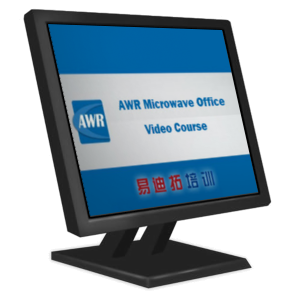- 易迪拓培训,专注于微波、射频、天线设计工程师的培养
Running Calibre DRC from AWRDE
How can I run Mentor Graphics' Calibre DRC using the AWR Design Environment (AWRDE)
The purpose of this article is to explain how to run Calibre DRC from within the AWRDE. It is assumed that Calibre DRC has been installed and is running on a UNIX or Linux computer. The details of how to set up Calibre DRC is beyond the scope of this article. For information on getting Calibre DRC running, contact your local Mentor Graphics representative.
Additionally, while we support Calibre DRC in earlier AWRDE versions, users are highly encouraged to use the latest version available because of many enhancements built in to support Calibre DRC. Some of the more significant enhancements are: support for secure shell (ssh), simpler user setup, area DRC, and the ability to mark errors as Checked or False.
The Calibre integration requires the CAL-100 feature in the
License File
. To determine whether or not you have this feature, perform the following steps from within the AWRDE:
Select File > License > Feature Setup
You must have CAL-100 in the Optional Features section.
If you do not have this feature, contact your local AWR Sales representative for assistance.
Calibre DRC runs on either a UNIX or Linux computer. In this article, "Linux" will be used generically to refer to either Unix or Linux. We support both remote shell (rsh) and secure shell (ssh) as communication protocols between the PC running AWRDE and the Linux machine running Calibre DRC.
For using rsh, AWRDE uses the Windows built-in rsh functionality. For using ssh, AWRDE uses a popular free ssh, telnet, and rlogin client called PuTTY. Note that PuTTY is required if you want to use ssh.
Follow these steps using either rsh or ssh to set up the AWRDE:
user.ini
file (from AWRDE's drop-down menu: Help > Show Files/Directories):
For rsh:
[CALIBRE_DRC]
Machine=name_of_Linux_machine_where_Calibre_DRC_runs
or
[CALIBRE_DRC]
Machine=UserName@name_of_Linux_machine_where_Calibre_DRC_runs
The second Machine= designation is useful if the user account names are different on the client and host machine where Calibre runs.
For ssh:
[CALIBRE_DRC]
Machine=name_of_Linux_machine_where_Calibre_DRC_runs
NetClient=PuTTY
Password=-i "Full path can include spaces\PuTTY_generated_private_key_file"
or
Password=-pw type_user's_Linux_password
Note that if you are using the "-pw" option, your password will be plainly visible to anyone viewing user.ini. Because of this, you may prefer the "-i" key approach, where a private/public key pair (both of which are encrypted) is generated using PuTTYgen, PuTTY's key generator. For more information on creating and using keys, refer to Chapter 8 of PuTTY's User Manual (Using public keys for SSH authentication).
After performing these steps, save and close your
user.ini
and text editor, and then close the Directories window.
In addition, if using ssh, the path to
putty.exe
needs to be specified in the Windows Path environment variable by right-clicking on My Computer, going to Properties > Advanced > Environment Variables, and adding the path to
putty.exe
. The default location is
C:\Program Files\PuTTY
.
AWR Microwave Office 培训课程套装,视频教学,帮助您快速学习掌握MWO...
上一篇:Setting Initial Conditions for HSPICE Simulations
下一篇:Running Assura DRC from AWRDE
 Microwave office专业系统的视频培训套装,帮助您从零开始,全面学习MWO的设计应用【More..】
Microwave office专业系统的视频培训套装,帮助您从零开始,全面学习MWO的设计应用【More..】
频道总排行
- Which CPW Line Models Support
- Problem Saving Layout Rulers in
- Calculate 3dB Bandwidth of Band
- AWR&'s GERBER File Format Details
- Using DXF Format with the AWR
- DXF Files Do Not Open in AutoCAD
- FAQ: Using Encrypted HSPICE Netlists
- Touchstone File Repair Utility
- How Can I Fix the Shorted Cir
- Failure initializing the AWR Sc
